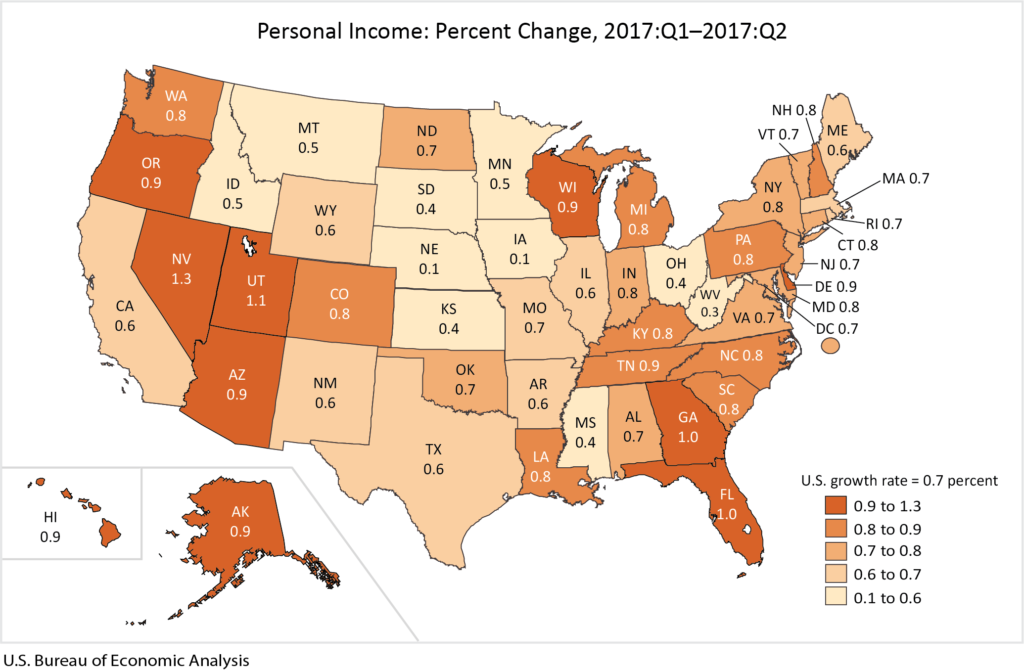Minnesota’s second quarter personal income growth figures show lackluster performance
Yesterday the Bureau of Economic Analysis released its estimates of the state’s personal incomes for the second quarter of 2017.
Minnesota’s personal income growth in perspective
Nationally, personal income grew by 0.7% from Q1 to Q2. In Minnesota, growth was lower, at 0.5%. Compared to the the four neighboring states, Minnesota performed better than Iowa (0.1%) and South Dakota (0.4%), but worse than North Dakota (0.7%) and Wisconsin (0.9%), as the figure below shows. Our state’s personal income growth ranked 42nd nationally.

For the same period in 2016, Minnesota’s personal income growth was 1.5%. This 1.0 percentage point decline was the second biggest in the US, ahead of Idaho. The national rate of growth slowed from 1.0% in 2016, to 0.7% in 2017, a 0.3 percentage point decline. Minnesota’s growth rate slowed more than that of any of the four neighboring states. Iowa (-0.9 percentage points), South Dakota (-0.5 percentage points), and North Dakota (-0.4 percentage points) all saw smaller declines while Wisconsin (+0.1 percentage points) saw an increase. Nationally, Minnesota’s slowdown was second only to, again, Idaho’s.
Changes in the components of personal income
Personal income can come from one of three sources: Earnings, Dividends, interest, and rent, and Personal current transfer receipts.
Earnings by place of work in Minnesota rose by 0.4% in the quarter compared to 0.9% nationally. Minnesota’s growth ranked 46th nationwide. Among its four neighboring states, Minnesota did better than Iowa (0.3% growth, 49th nationwide), as well as South Dakota (0.4%, joint 46th), and worse than Wisconsin (0.9%, 12th) and North Dakota (1.0%, 7th).
Dividends, interest, and rent in Minnesota rose by 1.0% in the quarter compared to 0.8% nationally. Minnesota’s growth ranked 4th nationwide. Among its four neighboring states, Minnesota did better than Iowa (0.8% growth, 18th nationwide) and South Dakota (0.8%, joint 18th), as well as Wisconsin (1.0%, 4th), and worse than North Dakota (1.2%, 1st).
Personal current transfer receipts need to be treated a little differently. These consist of “income payments to persons for which no current services are performed and net insurance settlements. It is the sum of government social benefits and net current transfer receipts from business”. These are not generally a sign of economic health. So, a higher rise and ranking is considered bad.
In Minnesota, these rose by 0.5% in the quarter compared to 0.2% nationally. Minnesota’s growth ranked 21st nationwide. Among its four neighboring states, Minnesota did better than than Wisconsin (0.9% growth, 9th nationwide), and worse than South Dakota (0.4%, 27th), North Dakota (-0.2%, 45th), and Iowa (-1.1% growth, 51st nationwide).
Minnesota’s lackluster economy
In the second quarter of 2017, Minnesota performed poorly on wages, well on dividends, slightly worse than average on transfer payments. We reported last year that Minnesota’s recent economic performance had been ‘mediocre’. As we find in our forthcoming update to that report and as these figures show, that still seems to be the case.
John Phelan is an economist at Center of the American Experiment.